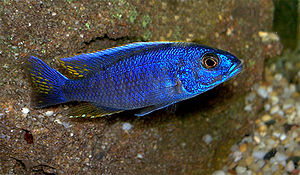Sciaenochromis
| Sciaenochromis | ||||||||||||
|---|---|---|---|---|---|---|---|---|---|---|---|---|

Azure cichlid ( Sciaenochromis fryeri ) |
||||||||||||
| Systematics | ||||||||||||
|
||||||||||||
| Scientific name | ||||||||||||
| Sciaenochromis | ||||||||||||
| Eccles & Trewavas , 1989 |
Sciaenochromis is a genus of African cichlids that is endemic to Lake Malawi in East Africa. Depending on the species, they can be between 12 and 20 centimeters in size.
features
Sciaenochromis was characterized by its predatory appearance, by the jaw dentition (simple teeth or with a slight tooth shoulder, set at a short distance from one another, in 3 to 4 rows, 84 in the outer row of teeth in the upper jaw, 55 to 65 in the lower jaw) and by the melanin color pattern (consisting of from a sloping series of spots and usually with traces of plesiomorphic vertical stripes)
Sciaenochromis is one of the most problematic genera of Malawi cichlids in terms of their delimitation. Authors such as Konings place those species with a sloping row of spots in the genus Mylochromis and leave only those with vertical stripes in Sciaenochromis . In the meantime, however, undescribed species have been found with which the morphological gaps between the genera Mylochromis , Sciaenochromis and even Stigmatochromis could be filled.
biology
Sciaenochromis predatorily feed on smaller fish. All Sciaenochromis species are maternal mouthbrooders . The males occupy territories at least temporarily, in which they create a shallow hollow and in which they lure females ready to spawn. During spawning, the female lays one batch of eggs (up to 100 in total), some of which are inseminated by the male while they are being laid, but also after the female has taken the eggs into her mouth. To do this, the female snaps at the male's anal fins, which releases sperm in the process. This process is largely ritualized. In other types of related mouthbrooders, there are still egg spots in the anal fin of the males, which suggest that the females have missed eggs. After a temperature-dependent incubation period of a little more than three weeks, the finished young fish are released from the mouth by the female and usually lured back into the mouth for the next few days even if they are concerned. Often, however, the female will guard the immediate area beyond this time, which gives the young a higher chance of survival.
species
- Sciaenochromis ahli ( Trewavas , 1935)
- Sciaenochromis benthicola Konings, 1993
- Azure cichlid ( Sciaenochromis fryeri ) Konings, 1993
- Sciaenochromis gracilis * (Trewavas, 1935)
- Sciaenochromis psammophilus Konings, 1993
- Sciaenochromis spilostichus * (Trewavas, 1935)
Species with a '*' are assigned to Mylochromis by Konings , but other authors revoke this.
Individual evidence
- ↑ Eccles, DH & E. Trewavas (1989): Malawian cichlid fishes. The classification of some Haplochromine genera. Lake Fish Movies, HW Dieckhoff, West Germany. 1-334.
- ↑ Snoeks, J. & M. Hanssens (2004): Identification guidelines to other non-mbuna. Pp. 266-310 in: Snoeks, J. (ed). The cichlid diversity of Lake Malawi / Nyasa / Niassa: identification, distribution and taxonomy. Cichlid Press, El Paso, Texas. 1-360.
- ↑ Konings. A. (1993): A revision of the genus Sciaenochromis Eccles & Trewavas, 1989 (Pisces, Cichlidae). The Cichlids Yearbook , 3: 28-36.
- ↑ Oliver, MK: Checklist of the Malawi "Hap" Species Flock (Alphabetically)
Web links
- Sciaenochromis on Fishbase.org (English)